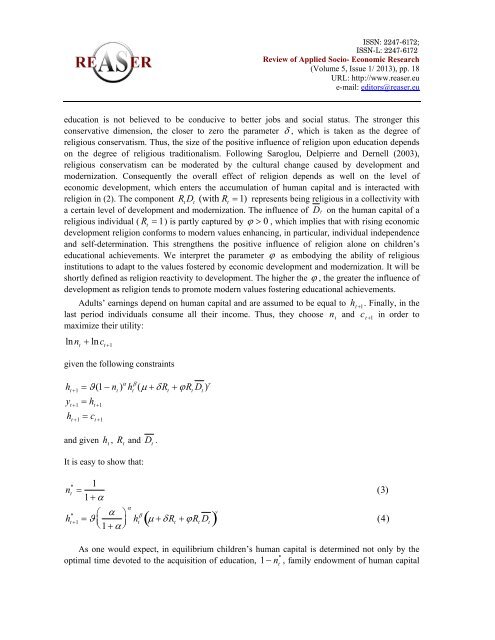new characteristics of inequalities in the information society and ...
new characteristics of inequalities in the information society and ...
new characteristics of inequalities in the information society and ...
Create successful ePaper yourself
Turn your PDF publications into a flip-book with our unique Google optimized e-Paper software.
ISSN: 2247-6172;<br />
ISSN-L: 2247-6172<br />
Review <strong>of</strong> Applied Socio- Economic Research<br />
(Volume 5, Issue 1/ 2013), pp. 18<br />
URL: http://www.reaser.eu<br />
e-mail: editors@reaser.eu<br />
education is not believed to be conducive to better jobs <strong>and</strong> social status. The stronger this<br />
conservative dimension, <strong>the</strong> closer to zero <strong>the</strong> parameter , which is taken as <strong>the</strong> degree <strong>of</strong><br />
religious conservatism. Thus, <strong>the</strong> size <strong>of</strong> <strong>the</strong> positive <strong>in</strong>fluence <strong>of</strong> religion upon education depends<br />
on <strong>the</strong> degree <strong>of</strong> religious traditionalism. Follow<strong>in</strong>g Saroglou, Delpierre <strong>and</strong> Dernell (2003),<br />
religious conservatism can be moderated by <strong>the</strong> cultural change caused by development <strong>and</strong><br />
modernization. Consequently <strong>the</strong> overall effect <strong>of</strong> religion depends as well on <strong>the</strong> level <strong>of</strong><br />
economic development, which enters <strong>the</strong> accumulation <strong>of</strong> human capital <strong>and</strong> is <strong>in</strong>teracted with<br />
religion <strong>in</strong> (2). The component R t<br />
D t<br />
(with R t<br />
1) represents be<strong>in</strong>g religious <strong>in</strong> a collectivity with<br />
a certa<strong>in</strong> level <strong>of</strong> development <strong>and</strong> modernization. The <strong>in</strong>fluence <strong>of</strong> Dt on <strong>the</strong> human capital <strong>of</strong> a<br />
religious <strong>in</strong>dividual ( R t<br />
1) is partly captured by 0 , which implies that with ris<strong>in</strong>g economic<br />
development religion conforms to modern values enhanc<strong>in</strong>g, <strong>in</strong> particular, <strong>in</strong>dividual <strong>in</strong>dependence<br />
<strong>and</strong> self-determ<strong>in</strong>ation. This streng<strong>the</strong>ns <strong>the</strong> positive <strong>in</strong>fluence <strong>of</strong> religion alone on children’s<br />
educational achievements. We <strong>in</strong>terpret <strong>the</strong> parameter as embody<strong>in</strong>g <strong>the</strong> ability <strong>of</strong> religious<br />
<strong>in</strong>stitutions to adapt to <strong>the</strong> values fostered by economic development <strong>and</strong> modernization. It will be<br />
shortly def<strong>in</strong>ed as religion reactivity to development. The higher <strong>the</strong> , <strong>the</strong> greater <strong>the</strong> <strong>in</strong>fluence <strong>of</strong><br />
development as religion tends to promote modern values foster<strong>in</strong>g educational achievements.<br />
Adults’ earn<strong>in</strong>gs depend on human capital <strong>and</strong> are assumed to be equal to h t 1<br />
. F<strong>in</strong>ally, <strong>in</strong> <strong>the</strong><br />
last period <strong>in</strong>dividuals consume all <strong>the</strong>ir <strong>in</strong>come. Thus, <strong>the</strong>y choose n t<br />
<strong>and</strong> c t 1<br />
<strong>in</strong> order to<br />
maximize <strong>the</strong>ir utility:<br />
ln n t<br />
ln c t 1<br />
given <strong>the</strong> follow<strong>in</strong>g constra<strong>in</strong>ts<br />
h t 1<br />
(1 n t<br />
) h t ( R t<br />
R t<br />
D t<br />
) <br />
y t 1<br />
h t 1<br />
h t 1<br />
c t 1<br />
<strong>and</strong> given h t<br />
, R t<br />
<strong>and</strong> D t<br />
.<br />
It is easy to show that:<br />
n t * 1<br />
1 <br />
*<br />
h t 1<br />
<br />
<br />
<br />
<br />
1 <br />
<br />
<br />
h t<br />
R t<br />
R t<br />
D t (4)<br />
As one would expect, <strong>in</strong> equilibrium children’s human capital is determ<strong>in</strong>ed not only by <strong>the</strong><br />
optimal time devoted to <strong>the</strong> acquisition <strong>of</strong> education, 1 n t * , family endowment <strong>of</strong> human capital<br />
(3)








